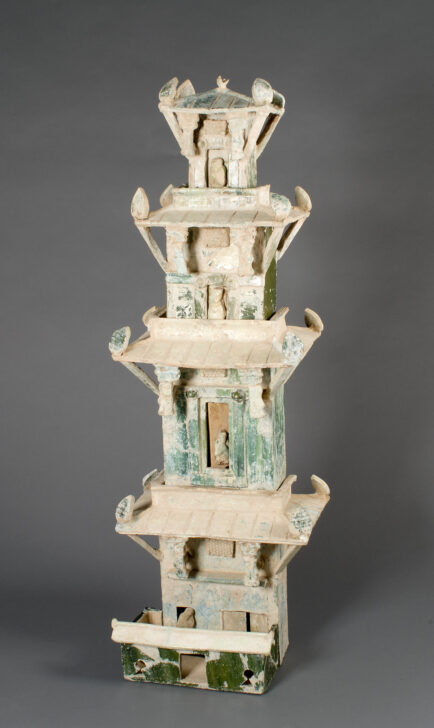Model of a four-storied pavilion
Chinese

Description
Copies and Invention in East Asia (August 17, 2019 - January 5, 2020)
Spirit Objects
By the Han dynasty (200 BCE–220 CE) in China, small-scale minqi, or “spirit objects,” made of soft, low-fired ceramics were the dominant form of burial goods. These lively sculptures offer a vivid picture of life on an estate. The most commonly represented animals are horses, dogs, pigs, and domesticated birds such as chickens and ducks; ducks were kept in a fenced pond, as seen in the example here. The impressive, tall structure is probably a watchtower, but towers also had symbolic meaning, as tall buildings were considered steps toward the celestial realm of gods and immortals. On top of the tower a bird spreads its wings, expressing the wish that the deceased will have an untroubled afterlife.
Throughout the Han dynasty (206 BCE- 220 CE), large quantities of funerary pottery, both glazed and unglazed, were made for burial with the deceased.
Known as mingqi (“bright vessels”), these pots fall into two categories—full-size vessels made specifically for funerals such as the five-bodied pot, and scale models of familiar objects like dogs and goat pens and this tall watchtower, constructed in four separate sections.
Until recently, Chinese villagers often slept together at night in gated structures similar to this in design in order to guard against armed marauders passing through the countryside. The ground-level unit of the tower is fortified by a high wall with a canopied gate and key-hole lookouts. This level shows shuttered doors and windows and is uninhabited, but ventilation and light are provided for by the latticework clerestory window overhead. The next three levels are for the inhabitants, who are seen watching out of a door or window. A bird, the traditional messenger between the world of the living and the dead, perches on the apex of the roof. In addition to insights into how Chinese lived in ancient times, pottery models like this offer us important information on early wood-frame architecture in East Asia.
(Label for UMMA Chinese Gallery Opening Rotation, March 2009)
Subject Matter:
By the Western Han dynasty, basic household bowls, plates, basins, jars, and the like were produced in great quantity, not only for use in daily life but also specifically for tombs as mingqi (明器, literally "bright objects") as a way to provide for the deceased. As these mingqi included everything one would need during the afterlife, these objects reflected daily life during the Han. Mingqi could include houses, towers, gates, granaries, livestock pens, chicken coops, wells, cooking stoves, storage vessels, dishes, incense burners, and lamps; they were also figures such as horses, dogs, anthropomorphic animals, officials, guardians, servants, and entertainers. The number of ceramic mingqi items in a tomb could reach numbers of a few to several hundred objects.
Mingqi included residential buildings such as this multi-storied tower. Most information we have of Han dynasty houses comes from architectural ceramic models and depictions on tomb bricks; only a few Han Dynasty buildings have been excavated, revealing modest sized to small structures. Upper middle class houses were one or two rooms surrounded by a courtyard and could be multiple stories. Houses of the well-to-do were heavily fortified with high walls and corner watchtowers with covered and elevated passageways, and they would have been confined to rural areas.
These ceramic models of multi-storied houses give important information about wooden post-and lintel construction during the Han dynasty. The majority of these structures are courtyard style walled residencies with a gated entrance; sometimes animals are represented in these courtyards. The houses generally have flat facades, with overhanging roof eaves supported by bracket sets, roof ridges with corner finials, balconies, lattice windows, open doors, and occupants in rooms looking out or on balconies. Commonly, a bird or owl is situated on the uppermost roof ridge as a conduit between the world of the living and the spirit world of the deceased.
Physical Description:
This red earthenware four-story pavilion is surrounded by a courtyard wall with a hipped roof covered gateway. Each story is similar in construction but graduated in size with the smallest story on top. These small, single-bay rooms feature a door entrance below a lattice window. Waving figures can be seen in the doorways. The overhanging roof eaves supported by a triple bracket set display roof ridges imitating tile work and provide the base for the next storey’s roof balcony. The entire structure is covered in a green lead glaze with iridescence and calcification.
Usage Rights:
If you are interested in using an image for a publication, please visit https://umma.umich.edu/request-image/ for more information and to fill out the online Image Rights and Reproductions Request Form.